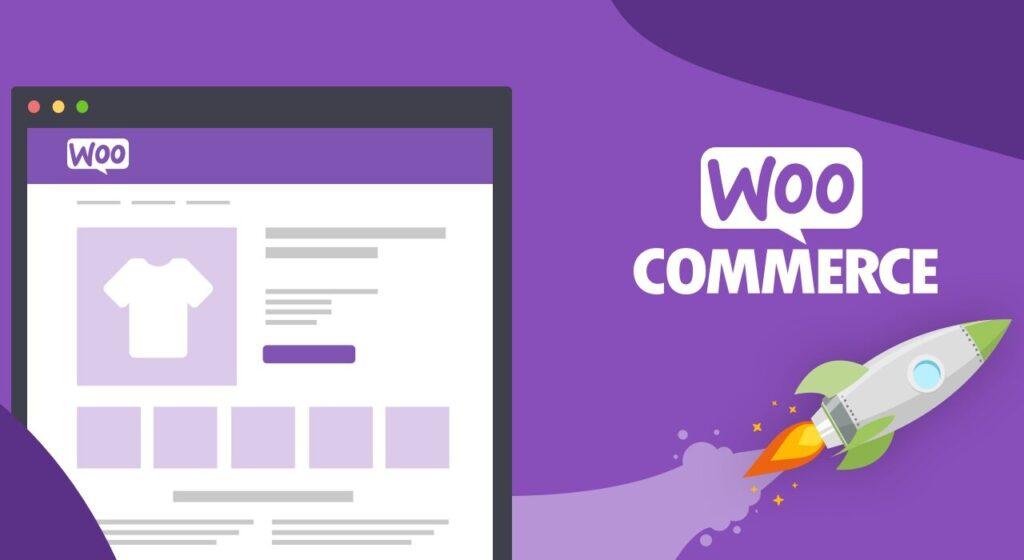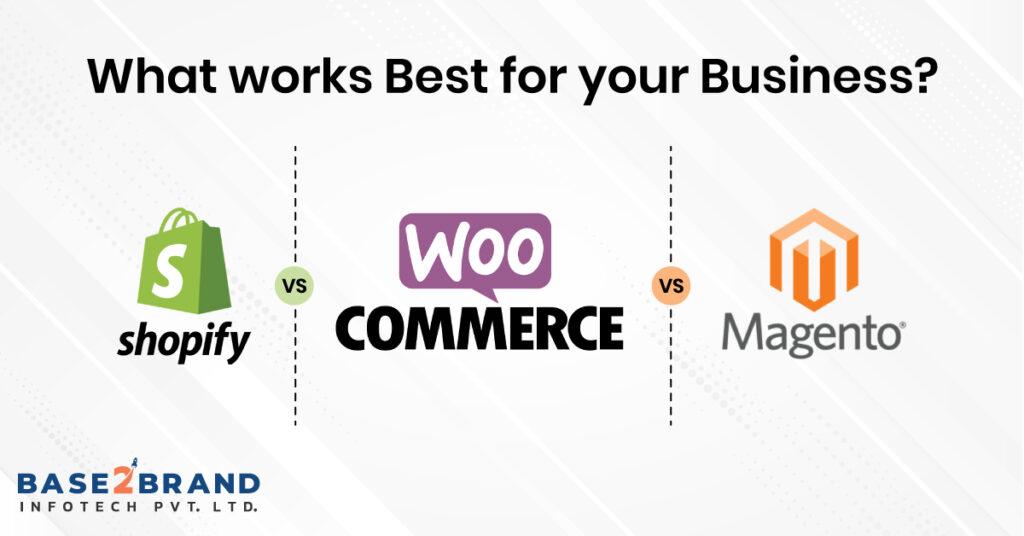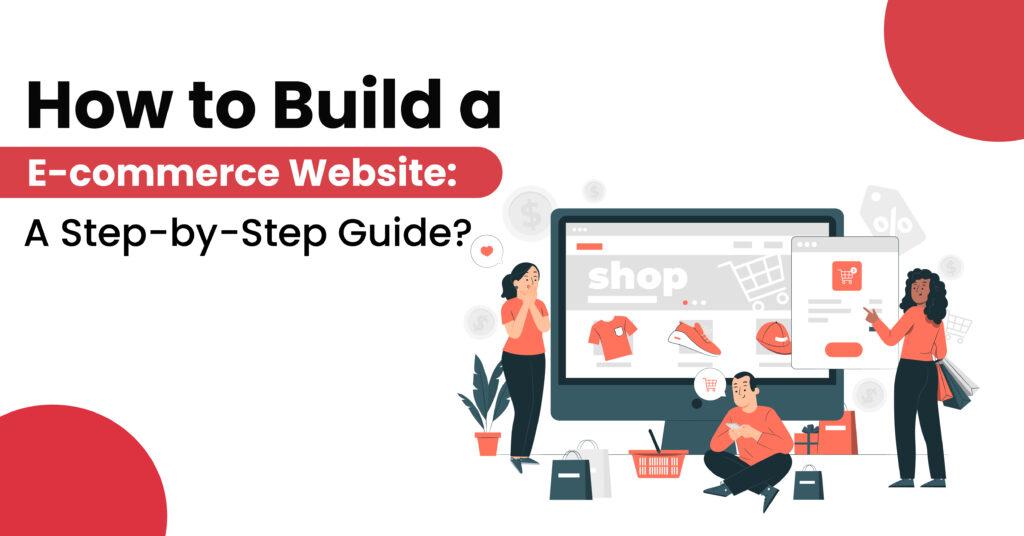Shopify vs WooCommerce vs Magento, What works best for your Business?
It is essential to select the best online store platform to build as well as manage and maintain an online store. This could be the deciding factor that will determine whether your venture will be a success in the future or not.
We have three options these days: Shopify, WooCommerce, and Magento. Each one of them is loaded with distinct capabilities, strengths, as well as weaknesses. Let’s do a comparison of Shopify vs WooCommerce vs Magento. We’ll give you all the information you need about these platforms, assisting you to pick the most suitable one for your company.
Shopify; A Brief Overview:

Shopify was established in 2004 by three snowboard enthusiasts who decided to build an online snowboard shop. The year 2006 was the year that Shopify received recognition as being one of the most successful businesses. The year 2015 saw Amazon remove its website, and advised its customers to use Shopify.
With Shopify, you can build a functioning e-commerce store in less than 15 minutes. Shopify is a subscription-based service and prices start at $29 per month for the base plan. It offers unlimited merchandise creation and storage for files indefinitely discount codes as well as 24/7 support two admin accounts, and more.
Shopify provides one-click integration with Google Analytics and hosts its own app store, which includes a wide range of extensions. Shopify also integrates with the most popular email platforms, like Avada, Mailchimp, and customer-generated email pop-ups. While digging deeper for a detailed Shopify vs WooCommerce vs Magento, we will look for few more features.
WooCommerce; A Brief Overview:

WooCommerce is an e-commerce plug-in that works with WordPress. In terms of selling and accessibility, WooCommerce is the leading online shopping platform. Over 5 million sites utilize WooCommerce. If you run a WordPress blog and you want to sell products then this is the right option.
WooCommerce is an open-source solution. Therefore, you can buy an individual design for the store, or incorporate commercial extensions that will make your site work better.
Through its built-in functions that allow you to offer physical, virtual, and affiliate products. In addition, you’ll receive the Ajax shopping cart and geolocation-related support, a flexible design, tax and shipping computation, Google analytics integration, and SEO optimization.
If you decide to pay for WooCommerce plugins, you’ll be able to include advanced features, including the ability to compare products, fast browsing pop-up notifications, various payment methods, and your preferred list of items. While digging deeper for a detailed Shopify vs WooCommerce vs Magento, we will look for few more features of WooCommerce
Magento; A Brief Overview:

Magento CMS was first introduced in March 2008, and is managed by Adobe since 2018. Today, there are over 700,000 websites across the world that are using Magento. Magento provides a variety of built-in features. You can change the language and currencies, include coupons, produce comprehensive reports, offer discounts on certain products, or for repeat customers and more. Customers can write reviews and also rate the products.
Furthermore, Magento Open Source provides numerous extensions and templates. You can even make modifications in code in HTML and PHP code to show specific options for your online store.
Magento enables you to set up several online shops and control them through one administration panel. While digging deeper for a detailed Shopify vs WooCommerce vs Magento, we will look for few more features of Magento.
Shopify vs WooCommerce vs Magento; Which is best for your company?
1. Shopify vs WooCommerce vs Magento: User-Friendliness
Shopify’s User-Friendliness:
A majority of store owners have rated Shopify to be the best platform for users available on the market. Shopify offers a drag-and-drop store builder, as well as numerous integrated tools that have an easy-to-use interface that will help you manage your business effectively.
- You can choose from pre-designed designs, meaning you don’t require any design expertise
- The templates are responsive in design that help keep your website adapt to all screen sizes, like tablets, desktops, and mobile phones.
- Online payment options are available to you. You don’t have to deal on sensitive credit card information. In addition, you can offer your items to Facebook friends.
WooCommerce’s User-Friendliness:
Before you are able to work with WooCommerce You must follow these steps:
- Have a domain name
- Sign up to host an account
- Install WordPress
- Set up a WordPress theme
After you have completed these above steps, you are able to install the WooCommerce plugin to your WordPress website. You may choose to hire a WordPress hosting service to handle the domain as well as WordPress installation. The only thing you need to do is the WooCommerce component.
After activating and installing after activating the WooCommerce plug-in on your website You’ll be able to see the wizard for setting up. It lets you select the primary parameters of your store and then get it installed. After the installation is complete it is now possible to start creating your shop and then begin adding products.
Magento User-Friendliness:
Magento isn’t the easiest to use. It doesn’t provide on-site developers to build your site. You’ll have to employ developers and a web hosting service to manage the operation of your Magento store.
Magento has a steep learning curve. It is necessary to have an understanding of cloud hosting HTML and CSS.
2. Shopify vs WooCommerce Vs Magento: Security
Shopify’s Security:
Shopify has the security features you need. So, you don’t need to worry about obtaining an SSL or getting attacked.
Shopify provides you with an SSL certificate included in the store. SSL is an acronym for Secure Sockets Layer that generally provides you with everything you need to safeguard your website from being hacked and to prevent data from leaking. Shopify’s integrated SSL ensures that each when someone visits your website, they’ll be able to see the small padlock icon on your website’s URL.
This certification helps protect your data while processing personal data as well as payments from customers. Additionally, your customers will be confident while visiting your site.
Additionally, Shopify is totally PCI-DSS compatible, which will allow your site to accept credit card transactions in accordance with the most recent rules. It is possible to begin accepting debit and credit card transactions immediately.
WooCommerce’s Security:
Contrary to Shopify You must take care of the safety of your WooCommerce store since it’s a self-hosted service. You may require help from a hosting provider to obtain the SSL certificate.
But, WordPress always keeps updating for security and bug fixes. The WordPress team continuously monitors and updates the code in order to prevent dangers.
Magento’s Security:
If you’re able to get enough developers and hosting solutions Security will not be an issue for Magento. The company is continually releasing security patches and prompt alerts to ensure that merchants will be aware of security issues.
Furthermore, there’s a variety of Magento security extensions. They can detect limits or prevent threats, enhance passwords, and check for changes to files and weaknesses.
3. Shopify vs WooCommerce vs Magento: Scalability and Performance
Shopify’s Scalability and Performance:
In terms of speed and performance, Shopify does a good job.
In the meantime, Shopify’s capacity can be a problem when your shop expands. If you’re looking for seamless scaling then you must consider Shopify Plus.
WooCommerce’s Scalability and Performance:
WooCommerce allows scalability, however, those with no programming skills may struggle to expand their stores to meet their needs.
Magento’s Scalability and Performance:
Magento 2.0 comes with a full collection of performance as well as scalability improvements that:
- Optimize web pages for quicker delivery
- Improve the response time of servers for all actions on the website
- Improve efficiency for backend operations
- Improve flexibility and scalability of databases to help manage high load
4. Shopify Vs WooCommerce Vs Magento: Customization and Design
Shopify’s Customization and Design:
One of Shopify’s greatest selling points is the high-quality themes. It’s simple for shoppers to download and use Shopify themes to enhance their stores.
Shopify currently has over 70 themes available in the theme store. The themes are designed for mobile devices and can be used with many different kinds of businesses with numerous color choices. So, customers can choose one that is compatible with their business’s style.
WooCommerce’s Customization and Design:
WooCommerce offers unlimited customization to its customers. Themes, plugins and extensions can be modified and coded to improve the functionality and appearance of your website. This allows you to better control the appearance of your site and the capability to add special features that will fulfill your company’s needs.
Magento’s Customization and Design:
Magento provides two themes as default: Blank as a basis for creating custom themes as well as Luma as a demonstration theme. The themes are based on a responsive layout that renders your storefront’s appearance on different devices.
In addition, Magento provides 16 other pre-designed themes for your store in its marketplace, and prices ranging from $0 and $499.
Magento provides you with infinite customization options for the design of your store due to its open-source nature.
5. Shopify Vs WooCommerce Vs Magento: SEO Features
Shopify’s SEO Features:
Shopify offers a set of SEO options for owners of stores to optimize their store’s content to get a greater SERP ranking. For instance, you can modify meta tags, add alt text for photographs, generate redirects to 301 and create auto XML sitemaps, etc. Moreover, this platform offers the user SSL certification for your checkout page as well as any content that is hosted within your own domain.
For strategies for marketing through content, Shopify has a blog that is packed with great features, like tags that are easy to set, numerous authors, and custom SEO parameters.
WooCommerce’s SEO Features:
As a plugin that is based on WordPress, WooCommerce has all of WordPress’ SEO capabilities. It lets you edit, and make metadata and content to ensure your products are able to rank at the top of search engine results.
WordPress provides a variety of modern SEO plugins, like Yoast SEO. Your shop can be optimized using this plugin’s incredible SEO features.
Magento’s SEO Features:
Magento is generally regarded as the most efficient eCommerce solution for optimizing search engines. The platform provides a wide range of features and extensions for companies to improve their SERP rankings.
Since it is open-source software, Magento enables users to modify their store’s appearance and SEO features at their discretion.
There are also remarkable features, including no-follow hyperlinks, Google sitemaps, redirects as well as canonical tags. These help search engines scan your store and understand its structure.
Shopify vs WooCommerce vs Magento;
Which one is best for Your Online Business?
When comparing the various aspects of these platforms it can be concluded that
- Shopify is the best platform for small businesses that are looking to expand their online businesses.
- WooCommerce can assist small and medium-sized enterprises to grow effectively.
- Magento is the ideal option for companies that have enormous resources.
It is important to think about every aspect of each platform in order to figure out the one that is suitable for your particular business and your goals for the future. We hope that you will discover the right solution quickly.










